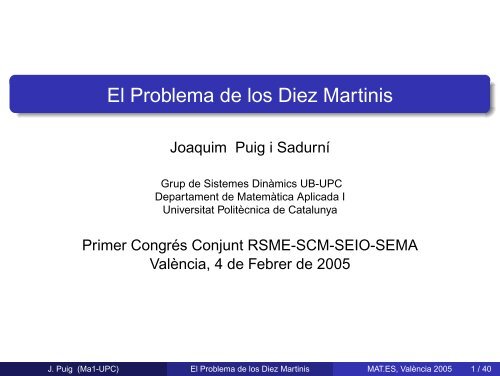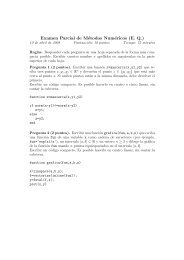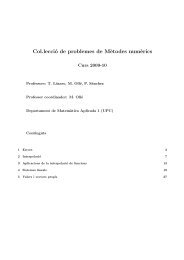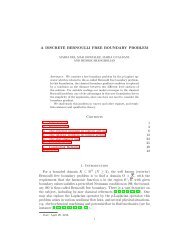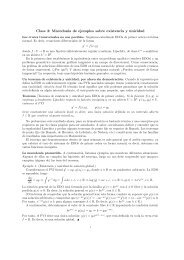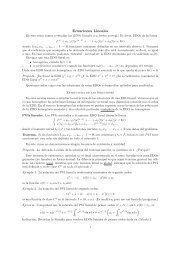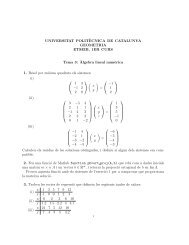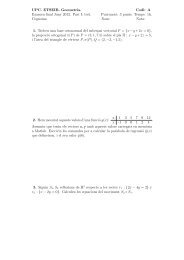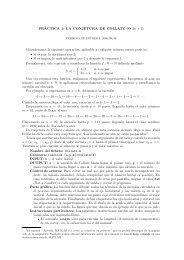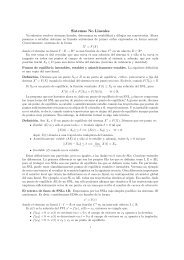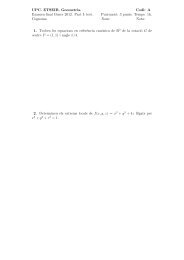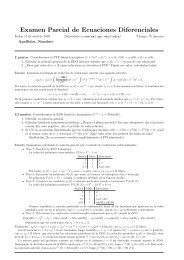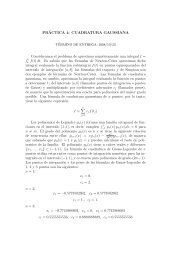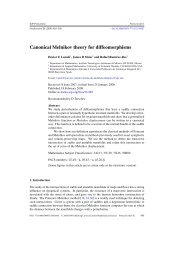El Problema de los Diez Martinis - MA1 - UPC
El Problema de los Diez Martinis - MA1 - UPC
El Problema de los Diez Martinis - MA1 - UPC
You also want an ePaper? Increase the reach of your titles
YUMPU automatically turns print PDFs into web optimized ePapers that Google loves.
<strong>El</strong> <strong>Problema</strong> <strong>de</strong> <strong>los</strong> <strong>Diez</strong> <strong>Martinis</strong><br />
Joaquim Puig i Sadurní<br />
Grup <strong>de</strong> Sistemes Dinàmics UB-<strong>UPC</strong><br />
Departament <strong>de</strong> Matemàtica Aplicada I<br />
Universitat Politècnica <strong>de</strong> Catalunya<br />
Primer Congrés Conjunt RSME-SCM-SEIO-SEMA<br />
València, 4 <strong>de</strong> Febrer <strong>de</strong> 2005<br />
J. Puig (Ma1-<strong>UPC</strong>) <strong>El</strong> <strong>Problema</strong> <strong>de</strong> <strong>los</strong> <strong>Diez</strong> <strong>Martinis</strong> MAT.ES, València 2005 1 / 40
<strong>El</strong> operador Almost Mathieu<br />
Consi<strong>de</strong>remos el operador Almost Mathieu:<br />
(H b,ω,φ x) n = x n+1 + x n−1 + b cos(2πωn + φ)x n , n ∈ Z<br />
en l 2 (Z), don<strong>de</strong><br />
b es un parámetro,<br />
ω es una frecuencia y<br />
φ ∈ T = R/(2πZ) es una (fase).<br />
Propieda<strong>de</strong>s<br />
H b,ω,φ : l 2 (Z) → l 2 (Z) es acotado.<br />
Es autoadjunto.<br />
Llamado operador <strong>de</strong> Schrödinger cuasiperiódico<br />
J. Puig (Ma1-<strong>UPC</strong>) <strong>El</strong> <strong>Problema</strong> <strong>de</strong> <strong>los</strong> <strong>Diez</strong> <strong>Martinis</strong> MAT.ES, València 2005 2 / 40
Espectro <strong>de</strong>l operador Almost Mathieu<br />
Si b = 0, el espectro es [−2, 2].<br />
<strong>El</strong> espectro es un subconjunto cerrado <strong>de</strong> [2 − |b|, 2 + |b|].<br />
Si ω es irracional,<br />
no <strong>de</strong>pen<strong>de</strong> <strong>de</strong> la fase φ.<br />
σ(b, ω) = Spec H b,ω,φ<br />
<strong>Problema</strong> <strong>de</strong> <strong>los</strong> 10 <strong>Martinis</strong> (Kac y Simon, 1981)<br />
Si b ≠ 0 y ω es irracional, σ(b, ω) es cantoriano.<br />
Demostraremos lo siguiente:<br />
Teorema (P. 2003)<br />
Si b ≠ 0, ±2 y ω es diofántico (condición <strong>de</strong> medida total), σ(b, ω) es<br />
un cantoriano.<br />
J. Puig (Ma1-<strong>UPC</strong>) <strong>El</strong> <strong>Problema</strong> <strong>de</strong> <strong>los</strong> <strong>Diez</strong> <strong>Martinis</strong> MAT.ES, València 2005 3 / 40
Aperitivo: De Almost Mathieu a Mathieu<br />
La ecuación <strong>de</strong> valores propios <strong>de</strong>l operador Almost Mathieu es<br />
x n+1 + x n−1 + b cos(2πωn + φ)x n = ax n , n ∈ Z,<br />
llamada la ecuación <strong>de</strong> Harper. Ésta es una discretización <strong>de</strong> la<br />
ecuación <strong>de</strong> Mathieu<br />
x ′′ + (a + b cos(t)) x = 0<br />
que, a su vez, es la ecuación <strong>de</strong> valores propios <strong>de</strong>l operador <strong>de</strong><br />
Mathieu . . .<br />
) (H b M x (t) =<br />
(− d 2 )<br />
dt 2 − b cos(t) x(t)<br />
que es un operador esencialmente autoadjunto en L 2 (R).<br />
J. Puig (Ma1-<strong>UPC</strong>) <strong>El</strong> <strong>Problema</strong> <strong>de</strong> <strong>los</strong> <strong>Diez</strong> <strong>Martinis</strong> MAT.ES, València 2005 4 / 40
Bandas y Agujeros espectrales<br />
Teoría <strong>de</strong> Floquet: <strong>El</strong> espectro <strong>de</strong> un operador <strong>de</strong> tipo Hill<br />
es la unión <strong>de</strong> bandas espectrales<br />
( )<br />
Hq H x (t) =<br />
(− d 2 )<br />
dt 2 − q(t) x(t),<br />
Spec(H q ) = [a − 0 , a+ 0 ] ∪ [a− 1 , a+ 1 ] ∪ . . .<br />
no vacíos,<br />
a − 0 < a+ 0 ≤ a− 1 < a+ 1 ≤ a− 2 < . . .<br />
Su complemento es la unión <strong>de</strong> agujeros espectrales,<br />
Res(H q ) = R \ Spec(H q ) = (−∞, a − 0 ) ∪ (a+ 0 , a− 1 ) ∪ (a+ 1 , a− 2 ) ∪ . . .<br />
J. Puig (Ma1-<strong>UPC</strong>) <strong>El</strong> <strong>Problema</strong> <strong>de</strong> <strong>los</strong> <strong>Diez</strong> <strong>Martinis</strong> MAT.ES, València 2005 5 / 40
¿Por qué Mathieu es especial?<br />
Ince (1927): Si b ≠ 0 todos <strong>los</strong> agujeros espectrales estan abiertos.<br />
6<br />
5<br />
4<br />
3<br />
2<br />
1<br />
0<br />
-2 -1 0 1 2 3 4 5 6<br />
J. Puig (Ma1-<strong>UPC</strong>) <strong>El</strong> <strong>Problema</strong> <strong>de</strong> <strong>los</strong> <strong>Diez</strong> <strong>Martinis</strong> MAT.ES, València 2005 6 / 40
¿Por qué Almost Mathieu es especial?<br />
Si calculamos <strong>los</strong> agujeros espectrales más gran<strong>de</strong>s en función <strong>de</strong> b:<br />
3<br />
2.5<br />
2<br />
1.5<br />
1<br />
0.5<br />
0<br />
0 0.5 1 1.5 2 2.5 3 3.5 4<br />
J. Puig (Ma1-<strong>UPC</strong>) <strong>El</strong> <strong>Problema</strong> <strong>de</strong> <strong>los</strong> <strong>Diez</strong> <strong>Martinis</strong> MAT.ES, València 2005 7 / 40
No siempre <strong>los</strong> agujeros estan estan abiertos...<br />
En general, <strong>los</strong> agujeros espectrales <strong>de</strong> un operador cuasiperiódico <strong>de</strong><br />
Schrödinger,<br />
(<br />
HV ,ω,φ x ) n = x n+1 + x n−1 + V (2πωn + φ)x n ,<br />
no tienen porqué estar abiertos (cf. Broer, P. y Simó 2003). Por<br />
ejemplo, si<br />
V (θ) = cos(θ) + 0.3 cos(2θ)<br />
1<br />
1<br />
0.9<br />
0.9<br />
0.8<br />
0.8<br />
0.7<br />
0.7<br />
0.6<br />
0.6<br />
0.5<br />
0.5<br />
0.4<br />
0.4<br />
0.3<br />
0.3<br />
0.2<br />
0.2<br />
0.1<br />
0.1<br />
0<br />
-2 -1 0 1 2<br />
0<br />
0 0.2 0.4 0.6 0.8 1<br />
J. Puig (Ma1-<strong>UPC</strong>) <strong>El</strong> <strong>Problema</strong> <strong>de</strong> <strong>los</strong> <strong>Diez</strong> <strong>Martinis</strong> MAT.ES, València 2005 8 / 40
<strong>El</strong>ectrones bajo un campo magnético<br />
Efecto <strong>de</strong> Hall clásico: <strong>El</strong> voltaje <strong>de</strong> Hall aumenta linealmente con el<br />
campo magnético.<br />
J. Puig (Ma1-<strong>UPC</strong>) <strong>El</strong> <strong>Problema</strong> <strong>de</strong> <strong>los</strong> <strong>Diez</strong> <strong>Martinis</strong> MAT.ES, València 2005 9 / 40
Efecto <strong>de</strong> Hall cuántico<br />
Von Klitzing (1980): En condiciones extremas el voltaje <strong>de</strong> Hall está<br />
cuantizado:<br />
J. Puig (Ma1-<strong>UPC</strong>) <strong>El</strong> <strong>Problema</strong> <strong>de</strong> <strong>los</strong> <strong>Diez</strong> <strong>Martinis</strong> MAT.ES, València 2005 10 / 40
<strong>El</strong> mo<strong>de</strong>lo <strong>de</strong> Peierls<br />
Peierls-Harper (1955) proponen el mo<strong>de</strong>lo dado por <strong>los</strong> operadores<br />
magnéticos en l 2 (Z 2 )<br />
(Uψ)(n, m) = ψ(n − 1, m), (V Φ ψ)(n, m) = e 2πinΦ ψ(n, m − 1),<br />
para (n, m) ∈ Z 2 , y el espectro <strong>de</strong>l operador<br />
h(Φ, c 1 , c 2 ) = c 1 (U + U ∗ ) + c 2 (V Φ + V ∗ Φ )<br />
como aproximación <strong>de</strong>l espectro <strong>de</strong> energía <strong>de</strong> un electrón en una red<br />
rectangular bajo un campo magnético perpendicular <strong>de</strong> intensidad Φ.<br />
Se ve<br />
Spec (h(Φ, c 1 , c 2 )) = ⋃ φ∈T<br />
Spec H b,ω,φ<br />
con<br />
b<br />
2 = c 2<br />
c 1<br />
y ω = Φ.<br />
J. Puig (Ma1-<strong>UPC</strong>) <strong>El</strong> <strong>Problema</strong> <strong>de</strong> <strong>los</strong> <strong>Diez</strong> <strong>Martinis</strong> MAT.ES, València 2005 11 / 40
La Mariposa <strong>de</strong> Hofstadter<br />
Si b = 2, Azbel (1962), Hofstadter (1976), Aubry (1978),<br />
J. Puig (Ma1-<strong>UPC</strong>) <strong>El</strong> <strong>Problema</strong> <strong>de</strong> <strong>los</strong> <strong>Diez</strong> <strong>Martinis</strong> MAT.ES, València 2005 12 / 40
La Mariposa <strong>de</strong> Hofstadter se engorda<br />
Si b = 1.75,<br />
J. Puig (Ma1-<strong>UPC</strong>) <strong>El</strong> <strong>Problema</strong> <strong>de</strong> <strong>los</strong> <strong>Diez</strong> <strong>Martinis</strong> MAT.ES, València 2005 13 / 40
La Mariposa <strong>de</strong> Hofstadter se engorda<br />
Si b = 1.5,<br />
J. Puig (Ma1-<strong>UPC</strong>) <strong>El</strong> <strong>Problema</strong> <strong>de</strong> <strong>los</strong> <strong>Diez</strong> <strong>Martinis</strong> MAT.ES, València 2005 14 / 40
La Mariposa <strong>de</strong> Hofstadter se engorda<br />
Si b = 1.25,<br />
J. Puig (Ma1-<strong>UPC</strong>) <strong>El</strong> <strong>Problema</strong> <strong>de</strong> <strong>los</strong> <strong>Diez</strong> <strong>Martinis</strong> MAT.ES, València 2005 15 / 40
La Mariposa <strong>de</strong> Hofstadter se engorda<br />
Si b = 1,<br />
J. Puig (Ma1-<strong>UPC</strong>) <strong>El</strong> <strong>Problema</strong> <strong>de</strong> <strong>los</strong> <strong>Diez</strong> <strong>Martinis</strong> MAT.ES, València 2005 16 / 40
La Mariposa <strong>de</strong> Hofstadter se engorda<br />
Si b = 0.75,<br />
J. Puig (Ma1-<strong>UPC</strong>) <strong>El</strong> <strong>Problema</strong> <strong>de</strong> <strong>los</strong> <strong>Diez</strong> <strong>Martinis</strong> MAT.ES, València 2005 17 / 40
La Mariposa <strong>de</strong> Hofstadter se engorda<br />
Si b = 0.5,<br />
J. Puig (Ma1-<strong>UPC</strong>) <strong>El</strong> <strong>Problema</strong> <strong>de</strong> <strong>los</strong> <strong>Diez</strong> <strong>Martinis</strong> MAT.ES, València 2005 18 / 40
La Mariposa <strong>de</strong> Hofstadter se engorda<br />
Si b = 0.25,<br />
J. Puig (Ma1-<strong>UPC</strong>) <strong>El</strong> <strong>Problema</strong> <strong>de</strong> <strong>los</strong> <strong>Diez</strong> <strong>Martinis</strong> MAT.ES, València 2005 19 / 40
<strong>El</strong> espectro <strong>de</strong>l Laplaciano (<strong>de</strong>splazado)<br />
Si b = 0, el espectro es el intervalo [−2, 2]<br />
J. Puig (Ma1-<strong>UPC</strong>) <strong>El</strong> <strong>Problema</strong> <strong>de</strong> <strong>los</strong> <strong>Diez</strong> <strong>Martinis</strong> MAT.ES, València 2005 20 / 40
IDS y el Operador Almost Mathieu<br />
Fijamos a, b y φ y sea<br />
k L,b,ω,φ (a) =<br />
1<br />
(L − 1) # { }<br />
valores propios ≤ a <strong>de</strong> H b,ω,φ | {1,...,L−1}<br />
con ciertas condiciones en la frontera. <strong>El</strong> límite<br />
lim k L,b,ω,φ(a) = k b,ω (a),<br />
L→∞<br />
llamado <strong>de</strong>nsidad integrada <strong>de</strong> estados (IDS), existe y cumple<br />
es in<strong>de</strong>pendiente <strong>de</strong> φ.<br />
es continua y no <strong>de</strong>creciente como función <strong>de</strong> a (b fijado).<br />
a ∈ σ(b, ω) ⇔ la IDS crece en a.<br />
J. Puig (Ma1-<strong>UPC</strong>) <strong>El</strong> <strong>Problema</strong> <strong>de</strong> <strong>los</strong> <strong>Diez</strong> <strong>Martinis</strong> MAT.ES, València 2005 21 / 40
IDS y funciones <strong>de</strong> Cantor<br />
1<br />
1<br />
0.8<br />
0.8<br />
0.6<br />
0.6<br />
0.4<br />
0.4<br />
0.2<br />
0.2<br />
0<br />
-2.5 -2 -1.5 -1 -0.5 0 0.5 1 1.5 2 2.5<br />
0<br />
-3 -2 -1 0 1 2 3<br />
1<br />
1<br />
0.8<br />
0.8<br />
0.6<br />
0.6<br />
0.4<br />
0.4<br />
0.2<br />
0.2<br />
0<br />
-4 -3 -2 -1 0 1 2 3 4<br />
0<br />
-5 -4 -3 -2 -1 0 1 2 3 4 5<br />
b = 0, 0.5, 1, 2, ω = ( √ 5 − 1)/2.<br />
J. Puig (Ma1-<strong>UPC</strong>) <strong>El</strong> <strong>Problema</strong> <strong>de</strong> <strong>los</strong> <strong>Diez</strong> <strong>Martinis</strong> MAT.ES, València 2005 22 / 40
Etiquetaje <strong>de</strong> <strong>los</strong> Agujeros Espectrales<br />
Johnson y Moser (1982): Si a ∈ ρ(b, ω) = R \ σ(b, ω)<br />
k(a, H φ ) = {nω}, ({·} parte fraccional) n ∈ Z.<br />
3<br />
-2<br />
1<br />
-4<br />
4<br />
-1<br />
2<br />
-3<br />
0<br />
-5 -4 -3 -2 -1 0 1 2 3 4 5<br />
Si k −1<br />
b,ω ({nω})) = [a −, a + ] ⇒ (a − , a + ) agujero abierto.<br />
Si k −1<br />
b,ω ({nω})) = {a ±} ⇒ {a ± } agujero colapsado.<br />
J. Puig (Ma1-<strong>UPC</strong>) <strong>El</strong> <strong>Problema</strong> <strong>de</strong> <strong>los</strong> <strong>Diez</strong> <strong>Martinis</strong> MAT.ES, València 2005 23 / 40
La Mariposa <strong>de</strong> Hofstadter Coloreada<br />
Avron y Osadchy (2003) pintan cada agujero con un color<br />
<strong>de</strong>pendiendo <strong>de</strong> la etiqueta...<br />
J. Puig (Ma1-<strong>UPC</strong>) <strong>El</strong> <strong>Problema</strong> <strong>de</strong> <strong>los</strong> <strong>Diez</strong> <strong>Martinis</strong> MAT.ES, València 2005 24 / 40
<strong>El</strong> <strong>Problema</strong> <strong>de</strong> <strong>los</strong> 10 <strong>Martinis</strong> <strong>de</strong> nuevo<br />
Recor<strong>de</strong>mos...<br />
<strong>Problema</strong> <strong>de</strong> <strong>los</strong> 10 <strong>Martinis</strong> (Kac y Simon, 1981)<br />
Si b ≠ 0 y ω es irracional, σ(b, ω) es cantoriano.<br />
Supongamos que ω es diofántico: existen c, τ > 0 que cumplen<br />
|sin 2πnω| ><br />
c<br />
|n| r , n ∈ Z \ {0}.<br />
Lo escribiremos como ω ∈ DC(c, τ). Entonces<br />
Teorema (P. 2003)<br />
Si ω es diofántico y b ≠ 0, ±2, σ(b, ω) es cantoriano.<br />
J. Puig (Ma1-<strong>UPC</strong>) <strong>El</strong> <strong>Problema</strong> <strong>de</strong> <strong>los</strong> <strong>Diez</strong> <strong>Martinis</strong> MAT.ES, València 2005 25 / 40
<strong>El</strong> problema fuerte <strong>de</strong> <strong>los</strong> 10 <strong>Martinis</strong><br />
(o el <strong>Problema</strong> <strong>de</strong> <strong>los</strong> 10 <strong>Martinis</strong> Secos)<br />
De hecho, Kac pidió <strong>de</strong>mostrar que el operador Almost Mathieu “tiene<br />
todos <strong>los</strong> agujeros abiertos” por lo que Simon propuso<br />
<strong>Problema</strong> fuerte <strong>de</strong> <strong>los</strong> 10 <strong>Martinis</strong> (Kac y Simon, 1981)<br />
Si b ≠ 0 y ω es irracional, σ(b, ω) tiene todos <strong>los</strong> agujeros espectrales<br />
abiertos.<br />
Po<strong>de</strong>mos <strong>de</strong>mostrar una versión perturbativa<br />
Teorema (P. 2003)<br />
Sea ω ∈ DC(c, τ) diofántico. Entonces existe una constante<br />
C = C(c, τ) tal que σ(b, ω) tiene todos <strong>los</strong> agujeros espectrales<br />
abiertos si<br />
0 < |b| < C o 4/C < |b| < ∞<br />
J. Puig (Ma1-<strong>UPC</strong>) <strong>El</strong> <strong>Problema</strong> <strong>de</strong> <strong>los</strong> <strong>Diez</strong> <strong>Martinis</strong> MAT.ES, València 2005 26 / 40
Repartiendo <strong>Martinis</strong> . . .<br />
Bellissard y Simon (1982): TMP si (b, ω) es genérico.<br />
Sinaĭ (1987): TMP si ω diofántico, |b| ≠ 0 pequeño.<br />
Helffer y Sjöstrand (1989): |σ(2, ω)| = 0 para ciertos ω.<br />
Choi, <strong>El</strong>liot y Yui (1990): STMP si ω Liouville (medida cero).<br />
Last (1994): |σ(2, ω)| = 0 para casi todo ω.<br />
Avila y Krikorian (2004): |σ(2, ω)| = 0 para <strong>los</strong> restantes ω.<br />
Avila y Jitomirskaya (2004) TMP para <strong>los</strong> restantes ω y b ≠ 0, ±2.<br />
J. Puig (Ma1-<strong>UPC</strong>) <strong>El</strong> <strong>Problema</strong> <strong>de</strong> <strong>los</strong> <strong>Diez</strong> <strong>Martinis</strong> MAT.ES, València 2005 27 / 40
Localización no perturbativa <strong>de</strong> Jitomirskaya<br />
Si b es gran<strong>de</strong>, H b,ω,φ = bD b,ω,φ próximo a diagonal<br />
⎛<br />
⎞<br />
. .. 0<br />
1<br />
cos(2πω + φ) b<br />
D b,ω,φ =<br />
1<br />
1<br />
b<br />
cos(φ) b<br />
.<br />
⎜<br />
1<br />
⎝<br />
b<br />
cos(−2πω + φ) ⎟<br />
⎠<br />
.<br />
0<br />
..<br />
Si b = ∞, operador diagonal, puramente puntual para cualquier φ ∈ T.<br />
Teorema (Jitomirskaya (1999))<br />
Sea ω diofántico. Si if |b| > 2 el operador Almost Mathieu, H b,ω,0<br />
, tiene<br />
espectro puramente puntual con funciones propias que <strong>de</strong>crecen<br />
exponencialmente para (Lebesgue) casi todo φ (incluyendo φ = 0).<br />
J. Puig (Ma1-<strong>UPC</strong>) <strong>El</strong> <strong>Problema</strong> <strong>de</strong> <strong>los</strong> <strong>Diez</strong> <strong>Martinis</strong> MAT.ES, València 2005 28 / 40
Rehaciendo el argumento <strong>de</strong> Ince...<br />
Sea b > 2 y ω diofántico.<br />
Jitomirskaya <strong>de</strong>muestra que, si b > 2, H b,ω,0<br />
tiene espectro<br />
puramente puntual con veps que <strong>de</strong>crecen exponencialmente.<br />
¿Qué necesitamos <strong>de</strong> este resultado?<br />
Los vaps σ pp<br />
b,ω son <strong>de</strong>nsos en σ b,ω<br />
y si a ∈ σpp<br />
b,ω<br />
, existe una<br />
solución no trivial <strong>de</strong><br />
ψ n+1 + ψ n−1 + b cos(2πωn)ψ n = aψ n , n ∈ Z,<br />
que <strong>de</strong>cae exponencialmente con |n|.<br />
¿Por qué es suficiente?<br />
Sea a uno <strong>de</strong> estos vaps y ψ = (ψ n ) n∈Z su vep (que <strong>de</strong>crece<br />
exponencialmente). Veamos que a es el extremo <strong>de</strong> un agujero<br />
espectral no colapsado<br />
J. Puig (Ma1-<strong>UPC</strong>) <strong>El</strong> <strong>Problema</strong> <strong>de</strong> <strong>los</strong> <strong>Diez</strong> <strong>Martinis</strong> MAT.ES, València 2005 29 / 40
La Dualidad <strong>de</strong> Aubry: I<strong>de</strong>a<br />
Supongamos que a ∈ σ(b, ω) es un valor propio puntual <strong>de</strong> H b,ω,0 cuyo<br />
vector propio, ψ ∈ l 2 (Z), <strong>de</strong>cae exponencialmente. Es <strong>de</strong>cir, a y ψ<br />
satisfacen<br />
ψ n+1 + ψ n−1 + b cos(2πωn)ψ n = aψ n , n ∈ Z,<br />
y, para unas ciertas constantes A, β > 0, |ψ n | ≤ A exp(−β|n|). La<br />
transformada <strong>de</strong> Fourier <strong>de</strong> ψ,<br />
˜ψ(θ) = ∑ n∈Z<br />
ψ n e inθ , θ ∈ T,<br />
analítica en |Im θ| < β, <strong>de</strong>fine una onda <strong>de</strong> Bloch cuasiperiódica<br />
x n = ˜ψ (2πωn + θ) , n ∈ Z,<br />
para θ ∈ T, cumple una ecuación <strong>de</strong> Harper!<br />
x n+1 + x n−1 + 4 b cos(2πωn + θ)x n = 2a<br />
b x n, n ∈ Z.<br />
J. Puig (Ma1-<strong>UPC</strong>) <strong>El</strong> <strong>Problema</strong> <strong>de</strong> <strong>los</strong> <strong>Diez</strong> <strong>Martinis</strong> MAT.ES, València 2005 30 / 40
Dualidad <strong>de</strong> Aubry y IDS<br />
Avron y Simon (1983): dualidad en términos <strong>de</strong> la IDS<br />
( ) 2a<br />
k b,ω (a) = k 4/b,ω<br />
, sia, b ∈ R, b ≠ 0,<br />
b<br />
por tanto<br />
σ (b, ω) = b 2 σ ( 4<br />
b , ω )<br />
.<br />
J. Puig (Ma1-<strong>UPC</strong>) <strong>El</strong> <strong>Problema</strong> <strong>de</strong> <strong>los</strong> <strong>Diez</strong> <strong>Martinis</strong> MAT.ES, València 2005 31 / 40
Ondas <strong>de</strong> Bloch para el sistema dual<br />
Si ˜ψ es la transformada <strong>de</strong> Fourier <strong>de</strong> (ψ)n , por Dualidad <strong>de</strong> Aubry<br />
x n = ˜ψ (2πωn + θ) ,<br />
n ∈ Z<br />
satisface la ecuación <strong>de</strong> Harper<br />
con<br />
x n+1 + x n−1 + β cos(2πωn + φ)x n = αx n , n ∈ Z.<br />
(α, β) =<br />
( 2a<br />
b , 4 )<br />
.<br />
b<br />
<strong>El</strong> sistema <strong>de</strong> primer or<strong>de</strong>n asociado<br />
( ) ( ) ( )<br />
xn+1 α − β cos(θn ) −1 xn<br />
=<br />
, θ<br />
y n+1 1 0 y n+1 = θ n + 2πω.<br />
n<br />
} {{ }<br />
A α,β (θ n)<br />
se llama skew-product cuasiperiódico en R 2 × T.<br />
J. Puig (Ma1-<strong>UPC</strong>) <strong>El</strong> <strong>Problema</strong> <strong>de</strong> <strong>los</strong> <strong>Diez</strong> <strong>Martinis</strong> MAT.ES, València 2005 32 / 40
La dinámica entra en juego . . .<br />
<strong>El</strong> skew-product cuasiperiódico es la iteración <strong>de</strong>l cociclo<br />
cuasiperiódico en SL(2, R) × T<br />
(v, θ) ∈ R 2 × T ↦→ (A α,β (θ), ω)) (v, θ) = (A α,β (θ)v, θ + 2πω)<br />
es <strong>de</strong>cir,<br />
v n+1 =<br />
( α − β cos(2πωn + φ) −1<br />
1 0<br />
) ( α − β cos φ −1<br />
· · ·<br />
1 0<br />
)<br />
· v 0 ,<br />
θ n = 2πωn + θ 0 .<br />
Dinámica <strong>de</strong>l cociclo ↔ Estructura <strong>de</strong>l espectro.<br />
J. Puig (Ma1-<strong>UPC</strong>) <strong>El</strong> <strong>Problema</strong> <strong>de</strong> <strong>los</strong> <strong>Diez</strong> <strong>Martinis</strong> MAT.ES, València 2005 33 / 40
Reducibilidad <strong>de</strong> Cocic<strong>los</strong>. Teoría <strong>de</strong> Floquet<br />
Dos cocic<strong>los</strong> (A, ω) y (B, ω) son conjugados si existe una conjugación<br />
Z : T → SL(2, R) continua tal que<br />
A(θ)Z (θ) = Z (θ + 2πω)B(θ), θ ∈ T.<br />
En este caso <strong>los</strong> skew-products<br />
u n+1 = A(θ)u n , θ n+1 = θ n + 2πω y v n+1 = B(θ)v n , θ n+1 = θ n + 2πω<br />
están conjugados por el c.d.v. u = Zv.<br />
Un cociclo (A, ω) es reducible a coeficientes constantes si está<br />
conjugado (B, ω) con B constante (matriz <strong>de</strong> Floquet). Solución<br />
fundamental sistema reducible: Representación <strong>de</strong> Floquet:<br />
X n (φ) = Z (2πnω + φ)B n Z (φ) −1 X 0 (φ).<br />
J. Puig (Ma1-<strong>UPC</strong>) <strong>El</strong> <strong>Problema</strong> <strong>de</strong> <strong>los</strong> <strong>Diez</strong> <strong>Martinis</strong> MAT.ES, València 2005 34 / 40
De ondas <strong>de</strong> Bloch a la Reducibilidad<br />
Volviendo a nuestro problema, tenemos<br />
( ) ( ˜ψ(4πω + θ) α − β cos θ −1<br />
=<br />
˜ψ(2πω + θ)<br />
1 0<br />
) ( ˜ψ(2πω + θ)<br />
˜ψ(θ)<br />
)<br />
, θ ∈ T.<br />
En este caso po<strong>de</strong>mos ver,<br />
Lema (Triangularización <strong>de</strong> Cocic<strong>los</strong>)<br />
Sea A : T → SL(2, R) analítica real y ω diofántico. Si existe v : T → R 2<br />
analítica real tal que<br />
v(θ + 2πω) = A(θ)v(θ), θ ∈ T,<br />
el cociclo (A, ω) es reducible a coeficientes constantes con<br />
B =<br />
( 1 c<br />
0 1<br />
)<br />
, para cierto c ∈ R.<br />
J. Puig (Ma1-<strong>UPC</strong>) <strong>El</strong> <strong>Problema</strong> <strong>de</strong> <strong>los</strong> <strong>Diez</strong> <strong>Martinis</strong> MAT.ES, València 2005 35 / 40
Extremos <strong>de</strong> Agujeros y Matrices <strong>de</strong> Floquet<br />
En general, dado un operador <strong>de</strong> Schrödinger cuasiperiódico<br />
(H V ,ω,φ x) n = x n+1 + x n−1 + V (2πωn + φ)x n , n ∈ Z,<br />
y su correspondiente cociclo <strong>de</strong> Schrödinger cuasiperiódico<br />
(( ) )<br />
a − V (θ) −1<br />
(A a−V , ω) =<br />
, ω , (1)<br />
1 0<br />
(V real analítico y ω diofántico por sencillez), supongamos que para<br />
cierto a, (1) es reducible a (B, ω). Entonces:<br />
a extremo <strong>de</strong> agujero no colapsado <strong>de</strong> Spec (H V ,ω,φ ) ⇔<br />
traza B = ±2.<br />
<strong>El</strong> agujero está colapsadao ⇔ B = ±I<br />
Por tanto, si<br />
( ) 1 c<br />
B =<br />
0 1<br />
entonces el agujero está colapsado ⇔ c = 0.<br />
J. Puig (Ma1-<strong>UPC</strong>) <strong>El</strong> <strong>Problema</strong> <strong>de</strong> <strong>los</strong> <strong>Diez</strong> <strong>Martinis</strong> MAT.ES, València 2005 36 / 40
<strong>El</strong> argumento <strong>de</strong> Ince<br />
En el caso <strong>de</strong>l Almost Mathieu . . .<br />
Si B = I (c = 0) hay dos ondas <strong>de</strong> Bloch analíticas e in<strong>de</strong>pendientes,<br />
soluciones <strong>de</strong><br />
x n+1 + x n−1 + β cos(2πωn + φ)x n = αx n , n ∈ Z.<br />
Pasando al dual, la ecuación <strong>de</strong> Harper<br />
x n+1 + x n−1 + b cos(2πωn)x n = ax n , n ∈ Z.<br />
tiene dos soluciones en l 2 (Z) l.i. ⇒ Contradicción con la constancia<br />
<strong>de</strong>l Wronskiano!.<br />
Por tanto B ≠ I (c ≠ 0) ⇒ 2a/b es extremo <strong>de</strong> un agujero espectral no<br />
colapsado <strong>de</strong> σ(4/b, ω).<br />
Como estos vaps a son <strong>de</strong>nsos en el espectro, <strong>los</strong> agujeros<br />
espectrales no colapsados son <strong>de</strong>nsos en el espectro.<br />
J. Puig (Ma1-<strong>UPC</strong>) <strong>El</strong> <strong>Problema</strong> <strong>de</strong> <strong>los</strong> <strong>Diez</strong> <strong>Martinis</strong> MAT.ES, València 2005 37 / 40
Hacia el STMP: el Teorema <strong>de</strong> <strong>El</strong>iasson<br />
STMP: “Todos <strong>los</strong> agujeros espectrales están abiertos”.<br />
Por Ince...<br />
Si a extremo <strong>de</strong> agujero <strong>de</strong> σ(b, ω) con (A a,b , ω) reducible a<br />
traza B = ±2, el agujero está abierto.<br />
Si todos <strong>los</strong> extremos son reducibles ⇒ STMP.<br />
Localmente tenemos...<br />
Teorema (<strong>El</strong>iasson (1992))<br />
Sea ω ∈ DC(c, τ) . Si |b| < C(c, r) y a está en el extremo <strong>de</strong> un<br />
agujero espectral, entonces (A a,b , ω) es reducible a (B, ω) con<br />
traza B = ±2.<br />
J. Puig (Ma1-<strong>UPC</strong>) <strong>El</strong> <strong>Problema</strong> <strong>de</strong> <strong>los</strong> <strong>Diez</strong> <strong>Martinis</strong> MAT.ES, València 2005 38 / 40
Conclusiones<br />
La combinación entre técnicas <strong>de</strong> tipo funcional y dinámico es<br />
muy útil para abordar la teoría <strong>de</strong> <strong>de</strong> Schrödinger cuasiperiódicos<br />
1D.<br />
Para <strong>de</strong>mostrar el problema fuerte <strong>de</strong> <strong>los</strong> 10 martinis fuerte hace<br />
falta una versión no perturbativa <strong>de</strong> <strong>El</strong>iasson.<br />
<strong>El</strong> operador Almost Mathieu es muy específico, aunque la<br />
estructura <strong>de</strong> Cantor pue<strong>de</strong> <strong>de</strong>mostrarse genérica.<br />
Des<strong>de</strong> un punto <strong>de</strong> vista dinámico, el estudio <strong>de</strong> <strong>los</strong> cocic<strong>los</strong><br />
cuasiperiódicos proporciona interesantes ejemp<strong>los</strong> y paradigmas.<br />
Es útil también en problemas <strong>de</strong> dinámica hamiltoniana.<br />
J. Puig (Ma1-<strong>UPC</strong>) <strong>El</strong> <strong>Problema</strong> <strong>de</strong> <strong>los</strong> <strong>Diez</strong> <strong>Martinis</strong> MAT.ES, València 2005 39 / 40
Referencias<br />
H.W. Broer, J. Puig, and C. Simó. Resonance tongues and<br />
instability pockets in the quasi-periodic Hill-Schrödinger equation.<br />
Comm. Math. Phys, 241(2–3):467–503, 2003.<br />
J. Puig. Cantor spectrum for the Almost Mathieu operator. Comm.<br />
Math. Phys, 244(2):297–309, 2004.<br />
J. Puig, and C. Simó. Analytic families of reducible linear<br />
quasi-periodic equations Prepublicación, 2004.<br />
J. Puig. Reducibility of Quasi-Periodic Skew-Products and the<br />
Spectrum of Schrödinger Operators. PhD Thesis, 2004.<br />
Universitat <strong>de</strong> Barcelona. Dir: C. Simó.<br />
J. Puig. A Nonperturbative <strong>El</strong>iasson’s Reducibility Theorem.<br />
Prepublicación, 2005.<br />
J. Puig (Ma1-<strong>UPC</strong>) <strong>El</strong> <strong>Problema</strong> <strong>de</strong> <strong>los</strong> <strong>Diez</strong> <strong>Martinis</strong> MAT.ES, València 2005 40 / 40


